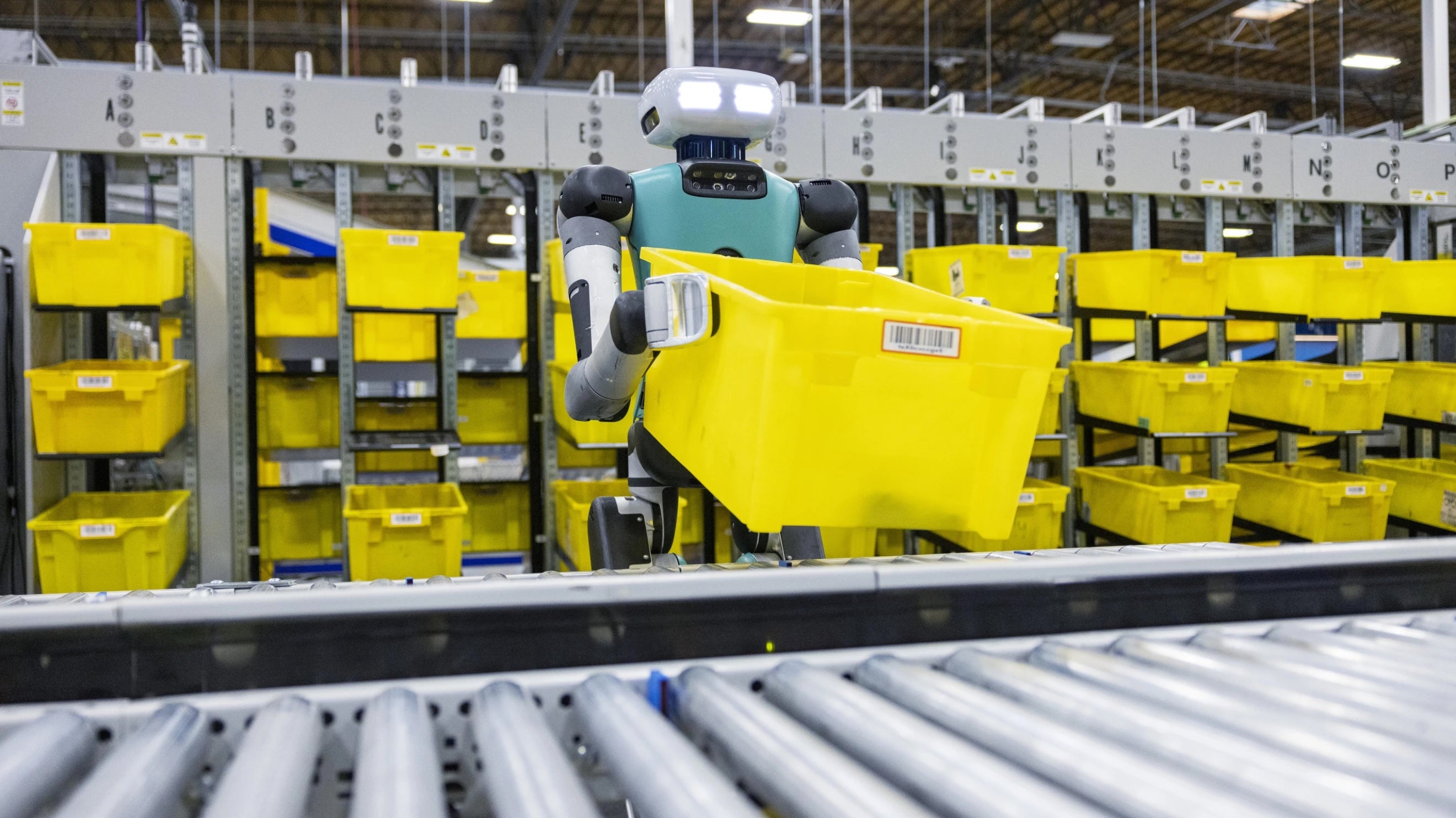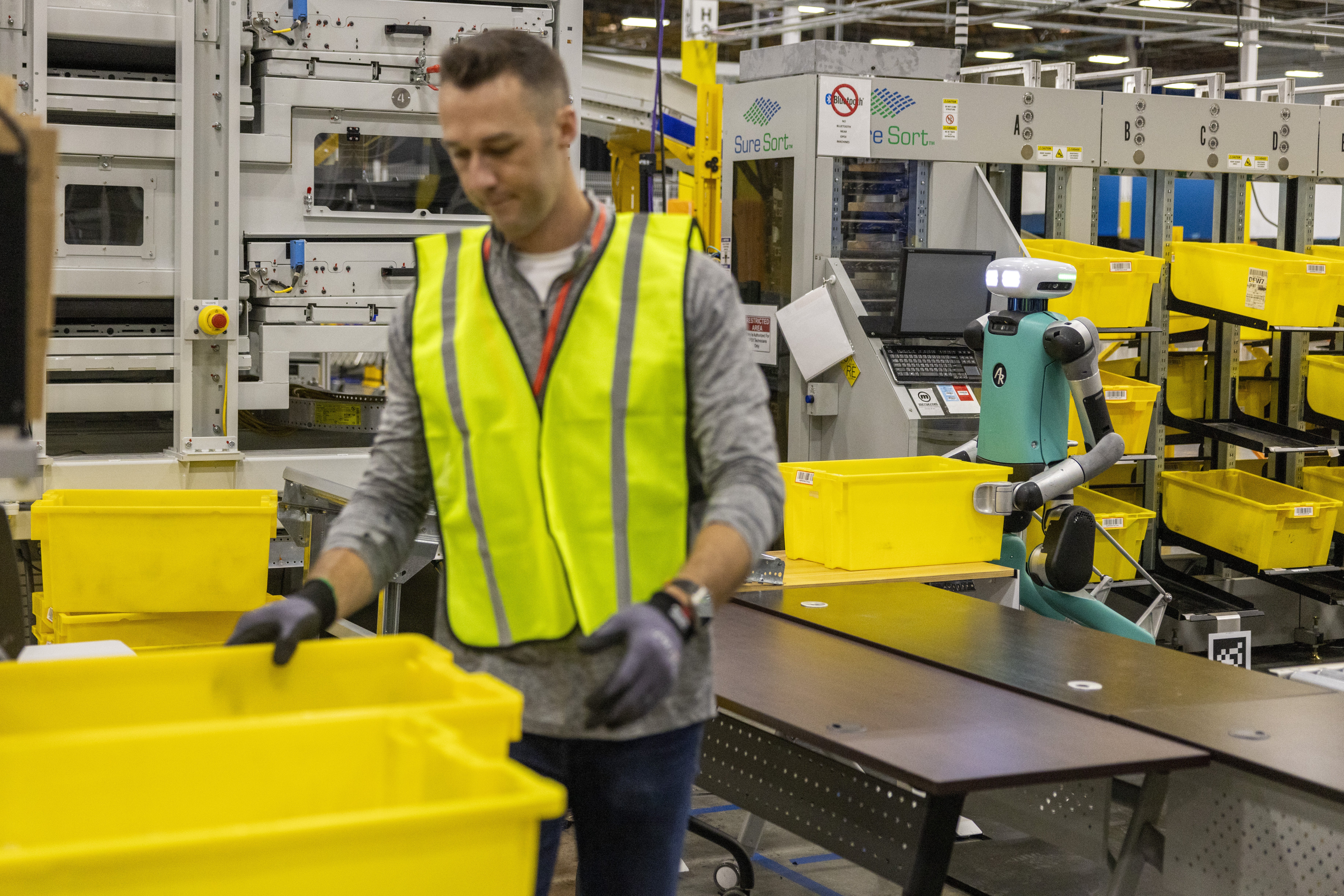Amazon has unveiled its new robot workforce – but what does it mean for its human staff?
Machines will change jobs not take them away, says Amazon – as it unveils a humanoid robot with glowing eyes that could eventually make deliveries to your door, writes Andrew Griffin


After a week in which Amazon has revealed walking robots that help pack deliveries and then new drones to fly and drop them off, the company is in reassurance mode.
All of these technological steps forward (literally in the case of the robots), do not mean that human jobs are at risk, insists the head of the company’s robotics division, Tye Brady.
He was speaking after his team showed off new advancements at their Seattle headquarters. Perhaps the most headline-grabbing of them was Digit, a humanoid machine capable of carrying around boxes, though that robot is just one among many.
Lots of Digit’s colleagues are already much more advanced in their work at Amazon. Many of Amazon’s warehouses – which it calls fulfilment centres – already rely heavily on automated systems that do work that was once done by humans.
In the past, for instance, Amazon workers would receive an order and head out into a forest of shelves filled with items, where they’d retrieve the right one and bring it back ready to be packed and sent off. Now, in many of its warehouses, the shelves instead come to the workers: small robots pick up the shelves themselves and rush them to the workers, who take the items and send them back on their way.

More automation is coming. For now, for instance, Amazon’s robots are mostly inside its warehouses – the packages that are made up there go out into the world to be delivered by humans. But Digit’s humanoid shape and powerful legs mean that it might be useful for getting around less stable environments like people’s driveways. Robots are expected to have a “pretty profound impact” all the way through Amazon’s delivery chain, says Brady, and so they might eventually arrive at your door.
Amazon says that the robots have made its work more efficient and more safe. But it has also, of course, led to fears that it will it will make those jobs redundant, when they are instead done by robots. The company is clearly concerned: alongside its announcements on robots this week, it also said that it would be launching new research with the Massachusetts Institute of Technology and polling company Ipsos to better understand how people feel about the robots that are arriving at their workplace.
But Brady also denies outright that the advance of robots means there will be fewer staff at Amazon. As efficiency increases, he says, Amazon will get more done; each building might have fewer staff, but Amazon will have more buildings. He points to the fact that Amazon’s investment in robotics began in earnest in 2012, and since then it has created hundreds of thousands of new jobs, and 700 new types of jobs.
Still, the threat from robotics and AI to jobs is real and growing. Earlier this year, Goldman Sachs estimated that new technology could replace the equivalent of 300 million jobs, which could also bring lower wages for those that remain. Jobs are already being lost to automation: in summer, for instance, BT said it plans to cut more than 40 per cent of its workforce in a shift to automated services.
Amazon says that it has robotics have not led to layoffs, and the workforce in its fulfillment centers has grown to 750,000 people. But it has received public criticism from unions over pay and other conditions. The UK’s GMB union called the automation plans a “head-first race to job losses”.
Brady says that certain kinds of work will go away, rather than workers. “I want to eliminate the mundane, the repetitive, the menial, the braindead type stuff,” he says. That is the kind of work that machines are better at; humans, on the other hand, are better at logical reasoning and problem solving, and Brady says he wants to free them up to do that instead.
Employees could still also work with the robots, he says: they might be supervising many machines at once, or looking to understand why certain items are not capable of being picked by robots, and so on.
Brady’s argument for that is based on the idea of purpose-based design, and giving actual people a key role in working alongside them. It highlighted a quote from Julia Shah, a professor of aeronautics and astronautics at MIT who is working on the Amazon research project, in which she said that “human-centered approaches to technology design and implementation reliably produce better results for workers and firms”. She suggested that the best job for a robot is as an “active collaborator” that works alongside actual people.
Part of the reason for that is because of the failings of robots. Brady says that there is “not any part of me” that ever thinks it will be possible to entirely automate the process of fulfilling customers orders at Amazon.
Robots get things wrong – even if they do so at a tiny rate, the company shipped 8 billion packages last year, so the errors could rapidly add up. Humans have certain capabilities that mean they will be key to stopping those errors: higher-level thinking, the capacity to spot problems, working off a “little computer we have [in our heads] that’s pretty lightweight and can work off a granola bar”. “That’s a pretty amazing computational piece of biology that we have up here, with a million years of evolution behind it; why in any world would you ever not want to leverage that?”

Speaking to the press, Brady had pointed to an idea that we tend to “overestimate technology in the short run and underestimate technology in the long run”; how does he know he’s not doing that now with its capability to surpass the human brain? After all, a few years ago we might have seen the capacity to draw artistic images or compose poetry as inherently and eternally human, but generative AI systems such as Dall-E and ChatGPT have made that less clear.
Even as those tools advance, he says, they are still only like a tool. Brady says he likes to paint and uses automatically generated images as inspiration – but his drawings are fundamentally more human and creative than an AI system could achieve. The new technology does not replace humans, just augments them, he suggests.
The same is happening in the medical field, for instance. “Machine learning systems can detect breast cancer better than a doctor, but it’s not the machine learning system that tells the patient about the breast cancer,” or does the treatment. The automated system is a “tool” that “allows doctors to be more effective at their tasks”.
That’s his vision for Amazon’s robotics, he says. “We’ve designed that machine in a way that allows us to be more productive, and also a safer environment for our employees. That care and thought and the voice of our employees has influencers our designers of the system to make a better machine to allow us to achieve, I think, some unprecedented work when it comes to e-commerce”.
Join our commenting forum
Join thought-provoking conversations, follow other Independent readers and see their replies
Comments